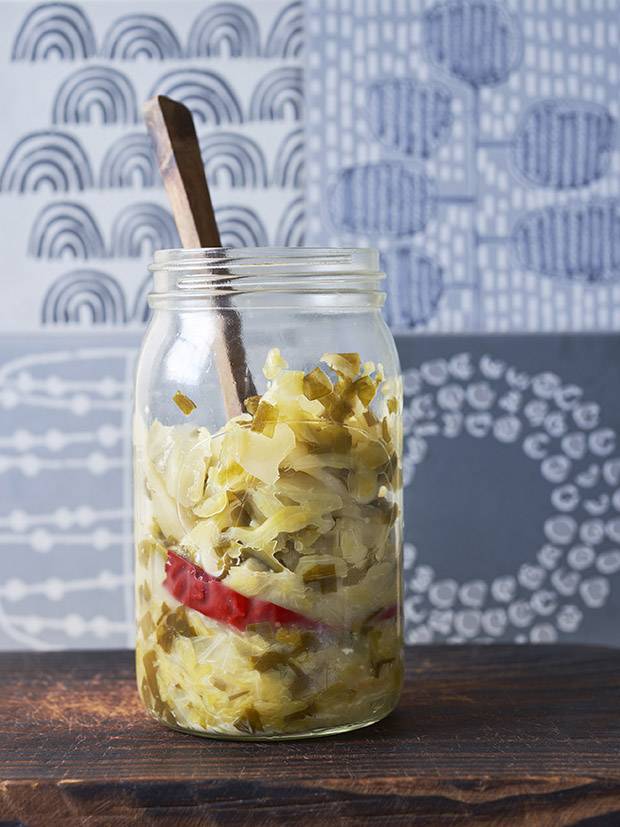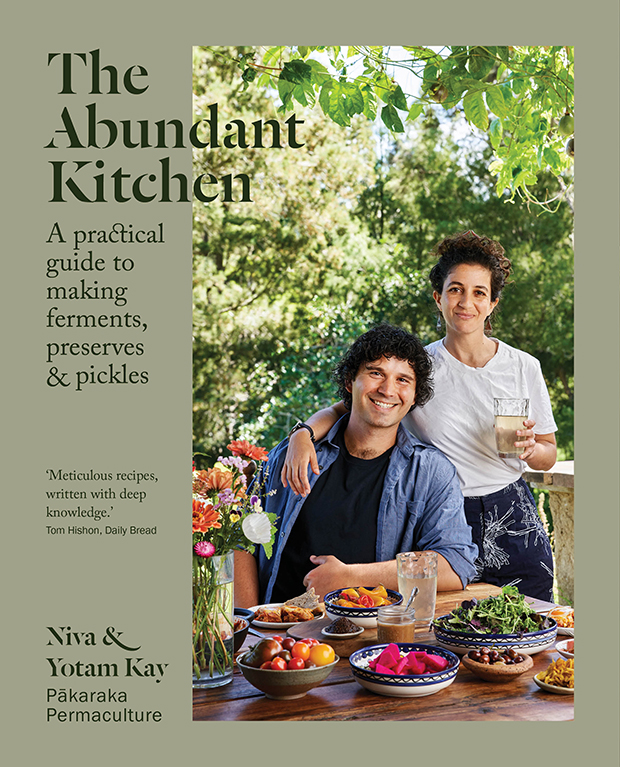Recipe: Sauerkraut with Spring Onion, Radish, Chilli & Ginger

A staple sauerkraut loosely inspired by kimchi.
Recipe: Extracted from The Abundant Kitchen by Niva & Yotam Kay
Makes: 1 litre (35 fl oz) jar
This recipe falls into the continuum that Sandor Ellix Katz, author of Wild Fermentation, calls krauchi. It is inspired by the rich flavours of Korean kimchi but is prepared with the sauerkraut method and flavour layering rather than the traditional kimchi method. We make this recipe when spring onions are at peak season (in spring). It is a great way to integrate big amounts of it into the kraut and come out with a great tasting, nourishing krauchi.
INGREDIENTS
300 g (10½ oz) daikon radish, sliced and bigger slices halved
100 g (3½ oz) spring onions, chopped
500 g (1 lb 2 oz) cabbage, chopped and kneaded as for Sauerkraut
15 g (½ oz) fresh ginger, grated or thinly sliced
15 g (½ oz) cloves garlic, peeled and halved
3 cayenne chillies, tops trimmed
basic brine, to top up if needed
METHOD
Mix all the ingredients except the chillies and brine in a bowl.
Pack one-third of the ingredients into a jar as per the Sauerkraut method then inlay one chilli against the edge of the jar. Keep packing up to the top of the jar, laying the other chillies in as you go. Place a large slice of daikon on top of the other ingredients to prevent them from floating, and weigh down. If the accumulated brine is not sufficient to submerge the veggies, top up with Basic Brine. Cover the jar with an airlock or slightly loose lid, and set it on a tray to catch any overflow. Keep the jar in sight in a cool location, and make sure to top up with fresh brine if the brine overflows or drops.
Ready to start eating in 1–3 weeks. Keep in the fridge once you are happy with the level of acidity.
Basic Brine
Makes: 250 ml (9 fl oz)
Brine is a solution of salt and water, and in many forms of fermentation and pickling it is the medium in which our ingredients are submerged. This basic brine is our most used brine. It has a ratio of two per cent salt to water and is a great all-purpose solution.
Interestingly, salt is not strictly necessary for lacto-fermentation, which happens because of the activity of the lactic acid bacteria (LAB). These bacteria love anaerobic conditions and will show up to do their thing either way, with or without salt. As they do, the pH of the ferment will decrease, which will further protect it from harmful microorganisms.
But, since LAB are salt-tolerant, using a salt brine is an easy way to maintain their population while stopping harmful microorganisms from colonising and contaminating our ferments. Salt has many other functions besides protecting the ferments. It is also used to draw out water from the vegetables to make up the brine in ferments such as sauerkraut, and to draw sugars from the vegetables to the brine, making it easier for LAB to feed on it. Finally, salt helps achieve crunchier ferments by hardening the pectin in the vegetables and reducing enzymic activity that promotes mushiness.
One to two teaspoons of salt per cup of water keeps our ferments safe and pleasantly salty. Use clean and unchlorinated water, or, if you are using chlorinated water, let it sit for a few hours before use. Look for non-iodised salt that doesn’t contain additives or anticaking agents, as they can inhibit the beneficial bacteria from flourishing. We use natural New Zealand sea salt in our ferments. Sea salt is more mineral-rich than table salt, which also improves the overall crunchiness of our ferments.
If you can provide ideal and controlled conditions or are planning a very quick fermentation, no or low salt might be feasible for you. We highly recommend using this simple safety measure to create the best results, improve your chance of success and minimise risks.
During the fermentation process, the brine soaks in all the different flavours in the jar, distributing them among all the vegetables in the jar. As a bonus, once you have finished eating, you can still use the brine for cooking, salad dressing or as a straight-up tonic.
INGREDIENTS
5 g (1/8 oz) salt
1 cup (250 ml/9 fl oz) water
METHOD
Add the salt to the water and stir until the salt has dissolved.

Recipes extracted from The Abundant Kitchen by Niva & Yotam Kay, photography by Aaron McLean, published by Allen & Unwin NZ, RRP $49.99.


